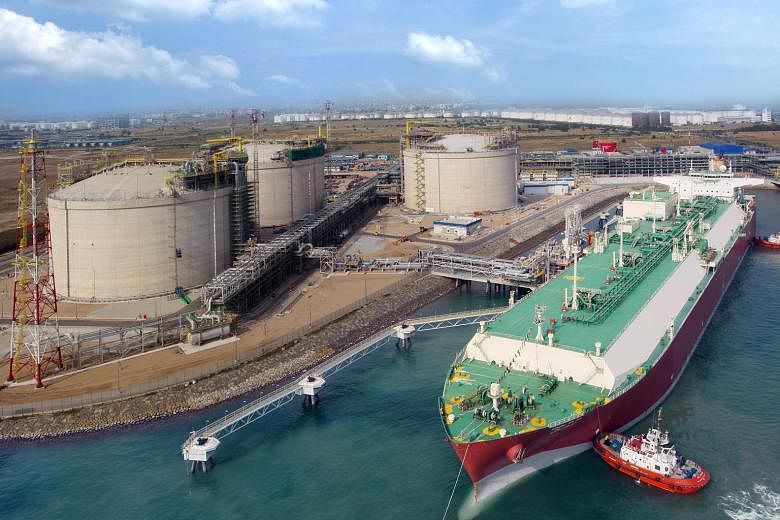The protracted weakness in oil prices will likely be just a blip in the road for Singapore's ambitions to become a regional liquefied natural gas (LNG) hub, say analysts and market players.
They note that the longer-term prospects remain favourable, especially with a new stream of supply set to come online in the coming years.
Singapore has been gearing up to become a regional LNG hub in recent years, in terms of both financial trading and physical handling capabilities. The first LNG import terminal opened here in 2013. It will have a throughput capacity of 11 million tonnes by next year, when its fourth LNG storage tank is up and running.
And last month, the Singapore Exchange (SGX) launched futures and swaps on Singapore's new price index for LNG, the SGX LNG Index Group (Sling).
But headwinds in the industry remain, with LNG prices having fallen in tandem with crude oil since June 2014. This is as natural gas traded in Asia has traditionally been pegged to crude prices, given that the region lacks a benchmark similar to the Henry Hub in the United States.
Cheap oil, as a result, has put a lid on demand for LNG globally, said Ms Kerry-Anne Shanks, vice-president of gas and LNG at Wood Mackenzie.
"The case for switching from oil to gas has gone away, with crude prices now at US$30 a barrel. And that's on top of the weaker economic outlook globally," she told The Straits Times in an interview last month.
Adding to that, spot prices for LNG are being capped by the oversupply in the Asian LNG market, with a further 130 million tonnes of supply to be made available by 2020, noted Ms Shanks. But she also believed that this upcoming supply "should support liquidity".
Platts Asia editorial director Vandana Hari said it is "natural" to see trading slow down "in an environment of low prices and lacklustre demand".
"And for any trading hub to operate successfully, it does need a fair amount of liquidity," she noted. "But Singapore is no stranger to the characteristic ups and downs that all commodity markets undergo. It's just a question of staying the course."
Singapore's role in LNG price discovery, said Ms Hari, is "all the more important" amid today's volatile conditions. "The more transparent and robust the price discovery system, the better for the market."
A spokesman for Pavilion Energy said that the longer-term view for global LNG "remains positive", with Asia set to continue to be a significant LNG buyer globally.
"An Asian LNG hub based on a gas-linked index will provide a more transparent and fair price for both LNG sellers and buyers," he said, referring to the Sling. "With the current oil price volatility and uncertainty, there is no better time to index the price of LNG in Asia to regional gas fundamentals."
In a report on Tuesday last week, the SGX said that the next one to two years will present "a clear window" for the Sling to be accepted as the Asian benchmark. It said that the liquid LNG spot market in Asia would "take time" to evolve, but many of the crucial elements were already emerging. These include the shift towards shorter term contracts, the move away from oil indexation and the removal of destination restrictions on cargoes.
At the same time, Singapore LNG Corporation (SLNG), which operates the LNG receiving terminal, said there are opportunities in the small-scale LNG segment, which includes LNG bunkering and the substitution of liquefied petroleum gas, diesel or fuel oil for LNG in industrial use and small-scale power generation. "With the infrastructure that we have built in Singapore, SLNG will be able to play a role in serving the small-scale LNG segment and facilitating its growth," said a spokesman for the firm, although he also acknowledged that such changes will require time, given the high capital cost involved in different segments of the LNG value chain.
For a hub to be effective and an index to emerge, both buyers and sellers have to commit to use it, said industry veteran Martin Houston, who is also chairman of United States-based LNG firm Parallax Energy. "Buyers will like the flexibility, and once a trading pattern emerges and pricing starts to reflect the true spot price of the commodity, it is more likely to grow quickly, at least to the capacity of the LNG storage available."


